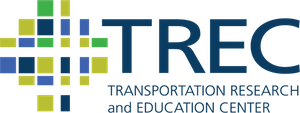Friday Transportation Seminars at Portland State University have been a tradition since 2000. With over 450 seminars presented and recorded (access the archive of seminars here), we host both visiting and local scholars to share the latest in research, technology, and implementation in transportation.
EDUCATION LIBRARY ARCHIVE
Missed the seminar or want a look back?
OVERVIEW
Knowing where one wants to go and how to get there are essential life skills for all people. Community access and travel skills are not only important rites of passage for youth in becoming adults, they are linked to higher rates of employment and overall health. People who are blind and visually impaired (BVI) face challenges in accessing public transportation, yet studies have shown that with relevant orientation and mobility instruction, technology, and accessible design, vision loss need not preclude community travel.
Join PSU's Amy Parker and Intel's Prateek Dujari on the ways that knowledge from consumers and the field of Orientation and Mobility can positively influence design through participatory conversations. After this presentation, participants will be able to: describe the role of Orientation and Mobility (O&M) Specialists; identify features in the built environment that benefit individuals with visual impairments as well as the broader population; and identify unique needs for travelers with visual impairments in the Pacific Northwest region.
THE SPEAKERS
Amy Parker, Portland State University
Amy Parker, EdD, COMS, is an assistant professor and the coordinator of the Orientation and Mobility Program in the Special Education Department. In 2009 she completed her doctorate in special education, with an emphasis in deafblindness and a certification in orientation and mobility, through a leadership and enrichment fellowship funded by the Office of Special Education. Using participatory methodologies with community stakeholders, she has worked to design accessible multimedia learning modules for national technical assistance and personnel preparation. Her research interests include orientation and mobility for individuals with complex disabilities, communication interventions, participatory action research with people with disabilities and their families, and community-based partnerships to create social change.
Prateek Dujari, Intel
Prateek Dujari is a product reliability engineer for network and data center products at Intel Corporation. He is Intel's only completely blind engineer. He joined Intel as a sighted person in 1999 and lost his sight in 2001 in a sudden unexpected manner while climbing a glaciated Oregon mountain. He has demonstrated an iron will to thrive by re-charting a successful career at Intel and a fulfilling social and recreational life. Prateek has a Master's degree in Mechanical Engineering, has nine technical publications and holds 16 patents. His proactive advocacy continues to increase accessibility of Intel’s internal computer based environment providing a more even competitive field for disabled employees. Careers and Disabled magazine recognized his accomplishments in 2014 with the Employee of the Year award. He Chaired the Oregon Commission for the Blind from 2015- 2017 and was instrumental in increasing the efficiency and accountability of the Commission by standardizing measurable and quantifiable metrics. Prateek is an avid athlete as an active runner, snowboarder, hiker, climber, tandem biker, kayaker and paddle boarder.
PROFESSIONAL DEVELOPMENT
This 60-minute seminar is eligible for 1 hour of professional development credit for AICP (see our provider summary). We provide an electronic attendance certificate for other types of certification maintenance.
LEARN MORE
Sign up for our newsletter and check the box for "Events" to receive monthly updates.
Photo Credit: Ben Churchill
Detailed directions for blind or visually impaired visitors:
The Harrison Street entrance to the Karl Miller Center is between 6th and Broadway on the north side of Harrison. Walking west from 6th Avenue, the entrance to the building will be on your right, about ten paces from the edge of the building or about 16 steps from the textured curb cut on the street corner. There are two shallow steps to your right, leading down to the glass double doors.
Once you're inside, you'll be facing a big open lobby area. The floor slopes down slightly, and there's a hand rail on the wall to your right. When you get to the end of the hand rail, keep walking in the same direction it was leading as if it continued in a perfectly straight line, and you should arrive at the opposite wall where there's another hand rail. (The room has two tables and two support columns to navigate around). Once you get to the other side of the lobby, if you come to a set of glass doors instead of a plain wall, then you're too far to the right. You need to follow the wall to your left until you reach the next hand rail. This rail will lead you to the elevators, which are on the same side of the wall as the hand rail. Since you're on the ground floor there's only one button.
On the 4th floor, you'll step out of the elevator and turn right. The room you're facing now is room 470; it's about 12-15 steps directly in front of you. There's usually a round table and chairs sitting by the wall in the hallway on the left side of room 470. Room 465 (where the seminar takes place) is the next room to the left, just past this table and chairs.



